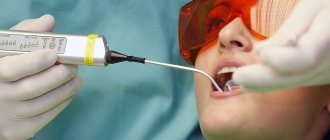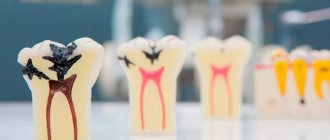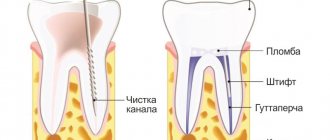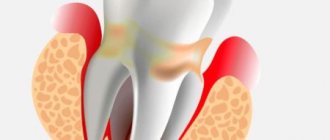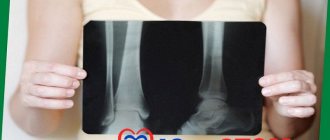High-quality restoration of contact chewing surfaces is the key to proper load on the teeth
When our teeth hurt or decay, all we want is to get rid of pain and discomfort, and also to protect them from removal. How the dentist will act in this case does not even matter to many patients. The main thing is that the work is done efficiently. But when it comes to the treatment and restoration of dental contact points, it is good to understand at least a little about the terminology and restoration methods that doctors use to carry out this incomprehensible procedure.
Reviews
Reconstruction of contact points is a complex but important stage in the treatment of carious cavities. Their presence is important for the stability and function of the restored tooth, and also affects all anatomical structures of the oral cavity.
You can share your experience of dental treatment with the reconstruction of their contacts, and share your opinion on the appropriateness of this manipulation by leaving a comment on this article.
If you find an error, please select a piece of text and press Ctrl+Enter.
Tags: teeth extensions
Did you like the article? stay tuned
No comments yet
Let's understand the terminology: what is a tooth contact point?
For many people, it is a mystery what the contact point between the teeth is. Let's figure it out.
Our teeth are located in the mouth in such a way that their lateral surfaces touch each other and thereby create a continuous arch, which is a single whole and forms a beautiful smile. This is provided that the person does not have any pathologies of the maxillofacial system or there are no missing units.
On a note! The contact point is easy to detect if you pay attention to the interdental spaces - they have a triangular shape in the gingival region, and the tip or apex of the triangle is directly facing the point of contact of the teeth.
If you open your mouth and look at its contents in the mirror, you will see that each tooth has a vestibular, i.e. on the external, visible side, in addition to the most frontal coronal part, there is a cutting edge, a neck and two contact (they are also called “proximal”) surfaces on each side, i.e. these are vertical areas facing neighbors. In those places or points (as a rule, these are the convex parts of the lateral surfaces of the crowns) where the tooth comes into contact with neighboring units, a contact point is formed. Incisors, canines, premolars always have two adjacent contacts on both sides (medial and distal) and only the outer molars in the row have only one such contact point (we are talking about sevens or eights, i.e. wisdom teeth, if you have any There is).
It is important to understand that there are several contact surfaces - lateral (one or two), as well as chewing ones. But it is the contact point that is called the lateral surface in the area of the apex of the crown of a living tooth.
Do wisdom teeth need to be treated?
It is assumed that in the past people's jaws were larger and the dentition was larger. With the transition to more high-calorie and soft foods, the jaw began to shrink, and the wisdom teeth began to interfere. At the same time, they erupt at a later age, often not completely, cause inflammation of the gums, and collect a large amount of plaque, which, due to the difficulty of removal, turns into tartar.
If wisdom teeth are causing concern, they are recommended to be removed. If the patient insists on preserving them, then, in agreement with the attending physician, treatment and polishing are carried out if they injure the cheeks with their protruding edges.
Types of contact points
Experts distinguish only two types, characterized by the peculiarities of the fit of the two proximal surfaces of neighboring units.
The first one is point. This type of contact is typical for children who have recently erupted teeth and for young adults. The crowns themselves in the area of contact have an almost ideal round or spherical shape, so they interact with each other only pointwise.
The second is planar. This type is typical for mature and elderly people, because... Over the course of life, the enamel gradually wears out and wears out, and the coronal part in the lateral areas gradually becomes flat as a result of friction and physiological mobility of the units. As a result, the lateral surfaces of neighboring teeth are no longer limited to point interaction, but have quite pronounced proximal areas or points.
Why are contact points needed?
The functions of dental contact points cannot be underestimated, because the health of the oral cavity as a whole, the condition of the maxillofacial system, and the aesthetics of a smile depend on their correct structure and location.
So, let's take a closer look at what having an anatomically correct contact point gives:
- the teeth are able to lean on each other and provide each other with support,
- each unit occupies its designated place in the row and is protected from loosening and displacement,
- in the presence of a contact point, a correct redistribution of the chewing load occurs: when a load is applied to the tooth during chewing, its coronal part is deformed due to a reduction in height and expansion in different directions. As the crown expands, the load is transferred throughout the row through the contact surfaces,
- The gingival papillae that fill the interdental spaces remain protected from food particles and injury.
If you have caries or, due to various circumstances, damage to the contact point occurs, then any irritant can cause the development of an inflammatory process on the gingival papillae. The same food debris that gets into the interdental spaces can injure the delicate mucous membrane and provoke a disease such as gingivitis. If the problem is not given attention, gum inflammation will be complicated by periodontitis, mobility, displacement, loosening and even tooth loss.
Also, if the anatomically correct contact of the lateral surfaces of the teeth is disrupted, one of them may eventually receive excessive occlusal load or pressure during chewing food and quickly begin to collapse. A characteristic sign indicating functional overload is vertical cracks in the enamel. The same traumatic occlusal load on the maxillofacial apparatus is characteristic of people who have had part of their teeth removed or lost, but are in no hurry to restore them, get prosthetics, or do implantation.
Why do contact surfaces fail?
Most often, the integrity of contact points and their anatomically correct location are violated due to the occurrence of a carious process in the adjacent areas and interdental spaces, which develops here due to inaccessibility and poor or insufficient oral hygiene. As mentioned above, the smallest pieces of food easily get into the spaces between teeth and get stuck; it is not always possible to clean them out on your own, and sometimes it is easy to notice. Moreover, the carious process in these areas can be difficult to identify independently, so it can remain unnoticed for a long time and progress, affecting several units at once. How to avoid this? Undergo preventive examinations in a timely manner. This should be done at least once every six months for adults, and 3-4 times a year for children.
Doctors, when faced with such defects, must not only take care of removing carious lesions and stopping the inflammatory process, but also begin restoring the contact point of the teeth during filling and prosthetics.
Basically, in their medical practice, dentists are faced with defects of class II and III caries according to the system developed back in 1986 by Black. The second class includes caries of the contact surfaces of molars and premolars, the third class includes the carious process on the lateral surfaces of the canines and incisors without disturbing the cutting edge. Class IV defects are also less common in practice, when not only the contact surface of the fangs and incisors is damaged, but also the cutting edge is destroyed.
Signs of destruction of contact points
Visually, the destruction of the lateral surfaces of the teeth or the presence of a carious process on them may remain unnoticed until a large cavity or black “hole” forms on the side of the crown. However, it is better if the problem is identified much earlier. To avoid missing it, pay attention to the following signs:
- painful sensations when eating food, temperature changes,
- food easily penetrates the interdental spaces and gets firmly stuck there,
- discoloration on the lateral parts of the crown: this sign can be detected quite easily if the front incisors and canines are damaged. The enamel stops shining, may acquire a white chalky tint, turn yellow or brownish,
- gingival papillae are inflamed and swollen,
- Bleeding gums began to bother me.
Methods for diagnosing the problem
Diagnosing a carious lesion in the area of the lateral surface of two teeth in contact with each other can be quite difficult even for an experienced dentist, especially if the units are crowded or closely located. That is why doctors sometimes use not one, but several different methods for diagnosing pathology:
- X-ray: it is always done because... with its help you can determine the depth of the carious lesion and the condition of the tissues surrounding it. In the picture, the carious areas will be black, the tooth itself will be gray, that is, much lighter than the inflamed area,
- digital method: using a special high-resolution video system, the doctor can transfer the image to his computer monitor, where he then comprehensively assesses the situation,
- Electroodontometry or EDI for short: allows you to identify the pathological process at the earliest stages of development. To determine the condition of soft and hard tissues, the doctor uses a special Diagnodent device that produces light pulses, which are then returned or reflected back. Based on the length of the pulse waves, the specialist determines the state of the areas under study. And the wavelengths in healthy and affected areas are completely different,
- transillumination: a special apparatus is also used for this, which literally illuminates all the examined areas. In those areas where the enamel-dentin layer is damaged or demineralized, the light takes on a different shade,
- colorimetry: here the patient is given to rinse his mouth alternately with different liquids. First use a methylene red solution, then use a glucose solution. In damaged areas, the PH level is changed and the acid-base balance is disturbed, so they “give” themselves a bright range of shades (yellow-red),
- vital staining: this procedure can be carried out only immediately after professional oral hygiene, then it will be most effective. The doctor applies methylene blue dye to the patient's enamel. The composition is kept for about 5 minutes, after which it is washed off with plain water. The result is painting in bright colors the areas where the carious process takes place.
Important! Before dental treatment or during a preventative examination, an experienced doctor will advise you to undergo professional oral hygiene - do not refuse this useful procedure. The procedure will help remove soft bacterial and hard plaque, which can serve as an obstacle to the correct diagnosis of various dental diseases and especially the diagnosis of caries in the proximal areas.
It is mandatory for doctors to conduct a visual examination using modern instruments. For example, endoscopes with bright LED lighting that transmit the resulting image to a monitor screen. In this case, the lateral areas of the teeth should be subjected to a comprehensive assessment, not only from the vestibular side, but also from the lingual, buccal, and occlusal side. A study is also carried out using a probe - thus, hidden carious lesions are detected against the background of bleeding of periodontal tissue.
Tools used for restorations
Restoring a tooth that has a damaged contact point is not an easy task for a dentist from a technical point of view. Standard caries treatment and fillings are not enough here. In order to restore the complex anatomy of the contact surface, it is necessary to use a set of special tools and devices, the main of which are matrices and wedges. Let's look at them in more detail.
Matrices
What is a matrix? This is a device that performs a kind of protective or restrictive function and helps to apply filling material for restorations in the required quantity. Using a matrix, a specialist models the surface and contact point, avoiding excessive layering of material. This limiter also does not allow it to go beyond the anatomical contour of a particular tooth. The device also protects the gingival papilla during manipulations.
Modern matrices for modeling surfaces can be made of plastic, metal or metal-plastic, can have different lengths (short, medium, long) and shapes - straight, contour or conical, perforated (flat and curved) for molars and premolars, volumetric. There are separation, protective or contouring (for modeling) models.
To firmly fix the device, the doctor uses matrix holders designed for this purpose: rings and clamps, couplings and clamps.
Wedges
Wedges perfectly complement the matrices. They have several main goals:
- protect the gingival papilla and the adjacent tooth from damage during manipulations and contact with filling material,
- separate the unit being restored from its neighbor,
- increase interdental space for high-quality subsequent procedures,
- allow for a higher degree of fixation of the matrix,
- allows you to recreate a triangular hole in the gingival area during the restoration process.
Wedges are made of wood and plastic, just like the matrices have different lengths and widths. When installed, they adapt to the anatomical features of the tooth.
Experts consider the most optimal option to use wooden wedges made from maple, because They are hypoallergenic, do not injure the mucous membranes and, in addition, perfectly absorb excess moisture. However, plastic is more flexible and pliable than wood, so when the patient’s teeth are very closely spaced and crowded, doctors prefer to use plastic wedges.
To facilitate work with proximal surfaces and for reliable and complete polymerization of filling materials in such difficult-to-reach areas, doctors also use the latest generation equipment. For example, a light-conducting cone that helps ensure polymerization of the composite. Tools and light-conducting attachments with built-in light sensors - with their help you can easily see the deepest cavities.
Material and recovery methods
Due to the development of aesthetic dentistry and the emergence of new materials for filling, it has become possible to restore any anatomical formation of teeth, including their contact point.
While working on it, the doctor needs to reconstruct:
- contact slope of the ridge;
- the contact itself;
- a hole in the gingival zone formed by wedging.
The need to recreate contact when teeth are damaged by caries arises when sealing cavities of classes II-IV.
For this purpose, the following are used: composite, a combination of GIC + composite with compomer, amalgam.
Sandwich technique
The essence of the technology is to apply a filling consisting of two layers , with glass ionomer cement used for the inner part of the tooth (dentin), and a composite for the outer part (the enamel is recreated).
The technique is considered as a replacement for adhesive technology and is applicable:
- in case of filling areas near the dental neck or root system;
- when filling large cavities;
- for reconstruction of pulpless elements;
- in the presence of concomitant systemic pathologies.
This technology is also preferred in the treatment of non-carious defects of hard dental tissues, when dentin or enamel are changed, as well as in the absence of the possibility of complete drying of the cavity.
There are two ways to place a two-layer filling:
- A sandwich of a “closed” type , when the gasket has no contact with the environment of the oral cavity, i.e. it does not touch the edges of the cavity, since it is covered on all sides with a composite mass.
- The sandwich is of an “open” type , i.e. the gasket comes into contact with the oral cavity after applying the composite. This option is preferable to use when closing class II cavities located in the subgingival area and it is impossible to perform complete drying.
Using a malleable composite
Using this technology, a viscous composite is used as an adhesive layer. To recreate contacts, two methods are used - passive, active.
In the first case, the composite is applied to the walls in a layer not exceeding 0.15 cm to the edges of the enamel, and then polymerization is carried out.
Next, layer-by-layer restoration of the gingival wall takes place using material of normal density. The cavity is sealed with a composite up to the cusps.
The second method is applicable only with a narrow gap between the matrix and the walls. The first portion of the material prepared for filling is applied in a layer of only 0.15 cm to all cavity walls to the very edge of the enamel (bypassing the gingival enamel) and is light-cured.
The remaining portion is applied over the gingival wall, but does not undergo polymerization. Then a packable composite or a regular one is applied and evenly distributed with a plugger.
Under pressure, a viscous composite fills a narrow area between the matrix and the unit being restored, then the cavity is restored using classical technology.
Berlotti technique
Upon completion of polymerization of the adhesive mass, a chemically cured composite material is introduced into the cavity. The shrinkage of the material in the area of the gingival wall is always directed towards the pulp chamber and soft tissues, since these areas have an increased temperature.
The remaining part of the cavity, without waiting for the material to harden, is filled with a light-curing composite mass and polymerized.
Camus technology
A small amount of the composite material is polymerized on a trowel and then placed into a cavity filled with a non-curing type of composite.
While the dentist fixes this portion to the matrix and presses it towards the adjacent unit, the assistant is engaged in photopolymerization of the entire filling material.
In practice, the most popular method of contact restoration among doctors is restoration (“passive”, “active”) using a flowable composite as an adhesive layer.
What types of matrices are better for modeling contact points?
It is impossible to answer this question unambiguously, because... the matrix must be selected based on many different factors. Depending on the clinical situation, the amount of work (macro- or micro-restoration is required), the stage of the procedure, the shape of the tooth and the anatomical features of the maxillofacial system, the doctor chooses one or another type of auxiliary instrument.
In the late eighties and nineties, doctors in their practice used cutout matrices to model contact points. But this device has shown its inconsistency over the years and is almost never used today, because such a matrix did not provide sufficient protection of the tooth neck and subgingival space from penetration of the composite there. And this situation often later became the cause of the development of chronic gingivitis. Today, this type of matrix is rarely used and only on the condition that the neck of the tooth is first coated with sealant.
In medical practice, there are also known methods according to which doctors completely refused to use auxiliary tools, namely, did not use wedges and matrices, or even rubber dams or rubber dams in their work. For example, the modeling method with sawing of contact surfaces implied the application of a composite material with a transition to the proximal surfaces. After this, the teeth in contact with each other were separated using an abrasive strip that resembled a hacksaw. This method also showed its inconsistency.
Today, some doctors prefer to use volumetric matrix modeling, because... they most accurately allow you to recreate the shape and anatomy of natural contact points.
Classification of matrices and fixation systems
Matrices and systems for their fixation are widely used for dental reconstruction.
In the manufacture of matrices, 2 types of materials are used: metal and plastic. When working with light-curing filling materials, it is more convenient to use plastic ones.
According to the shape of the matrix, they are produced in several types. They are made straight, they can be contoured or perforated.
Contour models are different for the outer and inner walls of the tooth. They vary in length and may have bulges and specialized shapes for different defects.
As for fixing systems, there are two main groups: matrix holders and wedges.
Matrix holders:
- For perforated matrices, a perforated holder is used;
- Sectional matrix system “3M” - fixes with spring rings;
- M. Tofflemeyer - a retainer for working with large defects, used both on the right and on the left. The matrix is put on the tooth and tightened with a coupling;
- Also for two- and three-channel teeth there are ready-made matrices equipped with a retainer; they are tightened with a clamp.
Wedges placed between the teeth can be of different sizes. They are made either from plastic or wood. They are needed to:
- create a triangular space between the teeth;
- wedge the teeth so that there is no gap left after removing the matrix;
- It is enough to secure the matrix tightly on the tooth.
A detailed review of the Glassix fiberglass pin set and quality characteristics of the products.
Come here to learn more about the features and purpose of gutta-percha points.
At this address https://www.vash-dentist.ru/krasota-i-uxod/narashhivanie/shtiftyi/parapulparnyie-kak-sposobov-vosstanovleniya.html we will consider the stages of placing parapulpar pins.
Preparation for the contact surface restoration procedure
First, the doctor carries out professional hygiene and antiseptic treatment of the oral cavity, puts the patient under anesthesia, and installs a rubber dam. Next, the specialist selects the necessary types of wedges and wedges two adjacent units. The wedge is always inserted from the tongue side, and the second end after installation should become noticeable from the vestibular side. After installing the wedge, you need to wait about 5-10 minutes so that the interdental space becomes clearly visible and nothing interferes with high-quality work.
Then the doctor opens and disinfects the carious cavity and removes the affected tissue. It is especially important to remove damaged tissue in the gingival area, because If this procedure is not carried out carefully enough, then there may subsequently be a risk of developing recurrent caries. Often in such cases, it is necessary to treat not just one, but several adjacent teeth, whose contact surfaces are in contact, for caries.
Next, depending on the clinical picture and indications, the doctor selects and fixes the matrix system, conditions the prepared cavity using special gels and applies an adhesive composition, after which he selects a technique for restoring or restoring both the tooth itself and its contact point with the neighboring unit.
Preparation
After carrying out diagnostic measures and establishing an accurate diagnosis, the patient undergoes several preparatory procedures for restoring contacts:
First, an anesthetic is injected. As soon as it shows its effect, the dental elements are “wedged” and their occlusal contacts are checked . For preparatory separation, wedges are selected that correspond to the parameters of the interdental space.
For this purpose, it is recommended to take wedges made of wood, which expand after absorbing moisture.
When inserting a wedge from the lingual side, its end must come out from the reverse side (vestibular), while the interdental papillae are necessarily pressed by its base.
If the tip of the wedge does not come out, the device is replaced with another (thinner) one, or another one is inserted from the opposite side.
All actions to correct violations begin 10 minutes after obtaining a visible and sustainable expansion of the interdental space.
From the chewing surface
When opening a cavity on the chewing surface, the enamel is first removed. If the pathology also affects the fissures, the cavities are combined.
From the side of the occlusal surface, smoothing (finishing) of the cutting edges is performed. In the area of the marginal ridge, the isthmus should be narrowed. Usually its width is equal to 1/4 of the interval between the cusps of the coronal part.
If the destruction of the cusps exceeds half the distance from the top of the cusp to the center of the fissure, they are shortened by 0.2 cm and then covered with a composite to reduce the likelihood of their spalling.
When a cavity is formed, the side walls are removed from contact with adjacent elements. At the border of the approximal and cervical surfaces, it is important to have an enamel thickness of at least 0.1 cm. Then it is beveled.
Particular attention is paid to the treatment of the gingival wall , since the remaining areas with demineralized enamel will subsequently cause recurrent caries. This wall is formed perpendicular to the vertical dental axis, and the enamel on the wall itself is smoothed out.
Access with a high clinical crown
In a state where the cavities are located below the contact with the vestibular or palato-lingual surface, it is recommended to perform the “tunnel (passage)” technique.
Tunnel preparation
The essence of the technique is that the cavity is not fully opened and the overhanging edges are cleaned out. The dentist creates something resembling a tunnel while preserving the dental tissues and cusps.
The preparation is carried out from the chewing side, and is characterized by a low quality view of the cavity walls, a risk of injury due to the likelihood of opening the pulp chamber, and the possibility of complications and unforeseen situations: ridge fracture and caries relapse.
Pros and cons of restoring teeth with anchor pins, main characteristics of products.
In this article we will talk about the intricacies of using fiberglass pins in dentistry.
Here https://zubovv.ru/krasota-i-uxod/narashhivanie/hudozhestvennaya-restavratsiya.html all the most important things about artistic modeling and restoration of teeth.
Materials for restorations
To recreate contact surfaces, doctors use different materials: hybrids, nanocomposites and composites of increased fluidity, compomers, glass ionomers, amalgam. A combination of composite and GIC is often used.
Flowable composites are characterized by a high degree of wear resistance, are well suited for surface modeling and can be polished, are elastic, easy to mix and conveniently applied using special dispensers.
As for compomers, they contain fluorine, which helps strengthen and regenerate hard tissues. This material is very resistant to moisture and has a high degree of adhesion.
Checking the quality of restoration
To determine the quality of the reconstruction of the contact formation, the dentist carries out the following actions:
- excess filling material is removed;
- the correct occlusal contact is checked;
- the marginal fit is examined with a probe or floss (the thread is inserted with some force).
The contact is considered to be of poor quality if the interdental space is clearly visible or the dental floss easily fits between the teeth. The restoration needs to be redone if the patient complains of food getting stuck between the teeth, or the floss breaking during hygienic cleaning.
The video provides additional information on the topic of the article.



